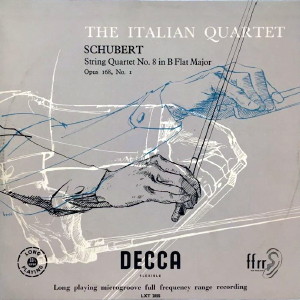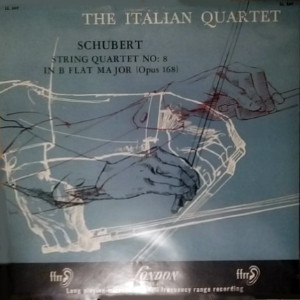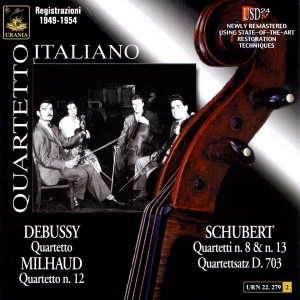 |
Decca
- 1 LP - LXT 2855 - (p) 03/1954
|
 |
| London -
1 LP - LL 669 - (p) 06/1954 |
 |
| Urania -
2 CDs - URN 22.278 - (p) 2005 |
|
| Franz Schubert
(1797-1828) |
|
|
|
|
|
|
|
| String
Quartet No. 8 in B flat major,
Opus 168 (D 112) |
|
31' 56" |
|
-
Allegro ma non troppo
|
11' 33" |
|
|
-
Andante sostenuto
|
9' 32" |
|
|
| -
Minuetto (Allegretto) - Trio |
6' 01" |
|
|
-
Presto
|
4' 50" |
|
|
|
|
|
|
THE NEW ITALIAN QUARTET
- Paolo Borciani, Elisa Pegreffi, violino
- Piero Farulli, viola
- Franco Rossi, violoncello |
|
|
|
|
|
Luogo e data
di registrazione |
|
Accademia di Santa
Cecilia, Roma (Italia) -
20-30 luglio
1952
|
|
|
Registrazione: live
/ studio |
|
studio |
|
|
Producer / Engineer |
|
John Culshaw, Victor
Olof | Gil Went
|
|
|
Matrici
78rpm |
|
Decca - IAR
589-96
|
|
|
Prima Edizione LP |
|
Decca - LXT 2855
- (1 LP) - (p) 03/1954 - Mono
London - LL 669
- (1 LP) - (p) 06/1954 - Mono
|
|
|
Prima Edizione CD |
|
Urania - URN 22.278 -
[2 CDs - (1°,
1-4)] - (p) 2005 - ADD
|
|
|
Note |
|
I riferimenti a
date e codici sono stati
desunti dal libro "Decca
Classical, 1929-2009" di
Philip Stuart.
|
|
|
|
|
Franz
Schubert, the
son of a school
teacher and the
twelfth child is
a family of
thirteen, was
born near Vienna
in January,
1797. As a child
he displayed an
extraordinary
musical
spiritude. Long
before the age
of ten he was a
capable
performer on the
piano and
violin, and had
a fine enough
voice to win
himself a
scholarship to
the Imperial
Chapel where, in
return for his
musical work, he
received a
general
education and
board. The
environment was
far from
ideal but the
tuition was
better than
anything his
parents could
have afforded,
and Schubert
survived the
material
hardships for
five
years-theough
not without an
occasional
bitter
complaint
about the
dismal
surroundings
and the
inadeguate
food.
There
was, however,
plenty of spiritual
sustenance,
and it was
through his
work with the
school that
Schubert first
gained
practical
knowledge of
the works of
Haydn, Mozart
and Beethoven.
He had already
been composing
for two years
when a
performance of
Mozart's G
minor Symphony
revealed to
him hitherto
unimagined
emotional
powers in
music; within
a year
of that
performance he
had written
his own first
Symphony.
He
left the
Imperial
Chapel in 1813
and took a
post in his
father's
school. It was
at this time
that he
discovered the
world of
opera, and it
is
characterictic
that non
sooner had he
heard
a series of
performances
than he
embarked on a
three-act
opera of his
own. But it
was already
clear that the
song appealed
to him more
than the
larger vocal
forms, and
between 1814
and 1817 he
wrote many of
those masterly
settings which
have never
been surpassed
Among them was
Gretchen am Spinnrade;
and
among the few
non-vocal
works of the
period was his
String Quartet
in B flat.
this work was
written in
1814, when
Schubert was
seventeen, but
the first
performance of
which we have
definite
record did not
take place
until 1862 at
the
Musikvereinssaal,
Vienna - some
thirty-four
years after
the composer's
death.
It
has been said
that Schubert
never
felt
completely at
ease when
composing
within the
bounds of
symphonic
form, but this
is a
proposition
difficult to
maintain
against the
evidence of
later works
like the C
major Symphony
or the String
Quartet. The
early B flat
Quartet does,
however, show
tendencies of
repetition and
variation
which some
critics have
found
unsatisfactory.
But in so
youthful a
work, are not
these
weaknesses
vitiated by
the undeniable
verve and
enthusiasm
dischernible
in every bar of
the Quartet?
On paper, the
finale appears
a little weak;
but in
performance it
comes to
life with an
enchanting
freshness.
The
first
movement, allegro
ma non troppo,
opens with a
lyrical theme
played by the
first violin.
Its second
statement is
shared by the
'cello and
both violins,
the viola
providing an
accompaniment
figure. But it
is the second
theme that
dominates the
movement: its
persistent,
restless
triplet figure
pervades not
only the
remainder of
the exposition
but generates
most of the
subsequent
development.
The latter is
a short
section of
some fifty
bars which
leads fluently
to the
recapitulation.
The brief coda
again stresses
the triplet
theme.
The
slow movement,
andante
sostenuto,
is
self-explanatory.
It is here
that Schubert
the song
writer comes
into his own,
as the simple
phrases which
open the
movement
gradually
expand into
the long
melodies for
which the
composer is
famous. In
this movement
it is again
the viola that
provides most
of the rich
accompaniment
to the flights
of the
violins. The
third movement
is an orthodox
minuet and
trio, but the
finale, presto,
is unusual in
that it is
virtually
monothematic.
There is, it
is true, a
"second
subject", but
it is so
similar to the
first that the
initial mood
remains
undisturbed.
The movement
opens with a
theme played
by the second
violin, viola
and 'cello,
whose phrases
are decorated
by a simple
staccato
figure played
by the first
violin. As the
movement
proceeds this
innocent and
sommingly
un-important
figure assumes
greater
importance and
becomes in
effect the
second
subject; by
this time it
has passed
from the first
violin and is
being shared
by the other
instruments.
This figure
dominates the
finale just as
the triples
phrase
dominated the
first
movement, and
a semple
re-statement
of the opening
themes brings
the work to a
close. This is
not music for
those
who insist on
profundity,
for its virtue
lies in uts
utter
simplicity: it
is a youthful
work, and
unmistakably
it conveys
the freshness
of youth.
LXT
2855
(rectus)
|
|
|